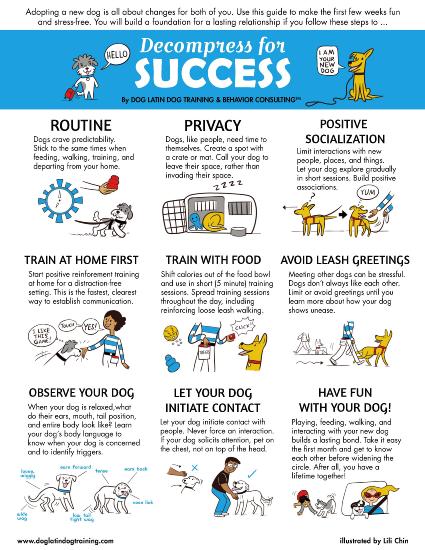Adopting a Dog: Getting Ready
Supplies List for Puppies
- Dog food
- Water bowl
- Food bowl
- Treats for training
- Enrichment items that can’t be eaten such as:
- A rolled-up towel with treats inside
- A Kong Wobbler with their kibble inside
- An Orbee Snoop with treats inside
- 6-foot leash
- Collar
- Harness
- A variety of toys (get a few different textures and options to see what they enjoy)
- Chews and teething toys (always supervise chewing time)
- For chews, we like Himalayan Yak chews, bully sticks, and puppy Benebones
- Bed (dog bed or blanket)
- Crate or baby gates and an exercise pen
Supplies List for Adult Dogs
- Dog food
- Water bowl
- Food bowl
- Treats for training
- Enrichment items
- 6-foot leash
- Collar
- Harness
- A variety of toys and chews (always supervise chewing time)
- Bed (dog bed or blanket)
- Crate
Puppy Confinement Area
-
Set up a space where your puppy can safely be alone when you are not actively watching them. This might be a kitchen with a baby gate, an exercise pen or a crate (for short periods of time).
-
In this area, place something soft to sleep on, a water bowl and several toys and chews.
-
Give your pup a special enrichment item, such as a stuffed Kong, when you place them in their confinement area so they look forward to their alone time.
Adult Dog Supervision
Adult dogs may or may not be potty trained when you bring them home. Be prepared to supervise or keep a leash on them indoors for the first few days to teach them the potty schedule and ensure they only potty outdoors. If they do not potty during a potty break, you can keep them on a leash until you go out again a few minutes later, or place them in their crate and try again in 10 minutes. See: Helping a Dog Adjust to a New Home
Next Steps
-
Establish a routine from the start. See: Helping a Dog Adjust to a New Home.
-
Remember to be patient and follow the 3-3-3 rule. See: The Rule of 3s
-
Introduce crate training. See: Crate Training Tips
-
For puppies, remember to carefully socialize them. See: Socialization Checklist
-
Ensure your pet is getting daily physical and mental exercise. See Enrichment: Brain Games for Mental Health
-
Need help with potty training? See: Puppies: Potty Training
-
Start training your dog right away! See: Training Should Be Fun!
-
Seeing unwanted behaviors from your new pet? See: Troubleshooting Common Behaviors

